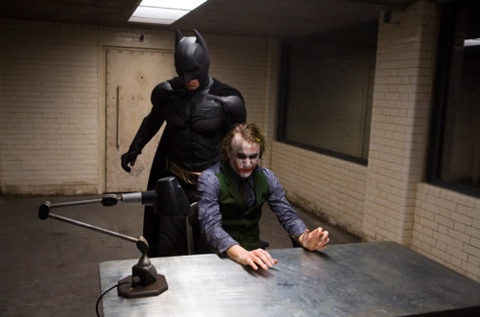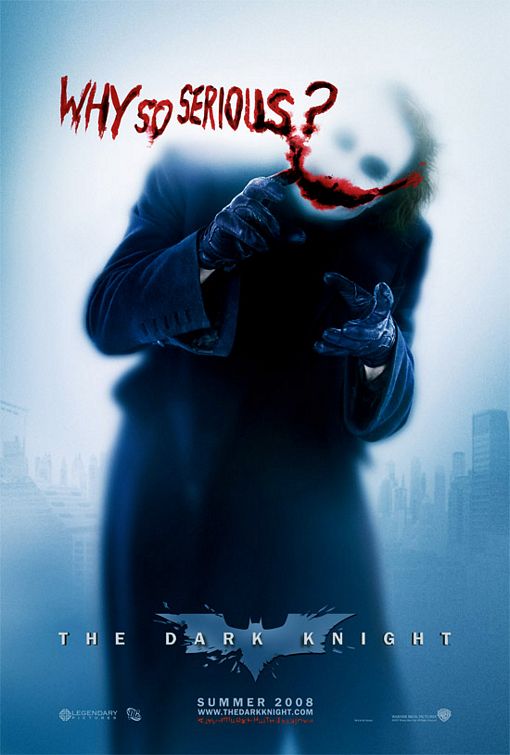Bat mailbag
Mon. August 11, 2008Categories: Abstract Dynamics
Some responses to the Dark Knight post…

Savonarola:
- The relentlessness of the time-torture motif, and the laying bare of all its psychic contradictions, is quite a testament to how impacted in it is in the American mindset (and it wouldn’t be too farfetched to see DK as a kind of negative-dialectical dismantling of the reassuring virility of 24 scenarios). The real political “problem” with the films (which is also a political insight) is the amorphous impotence/homogeneity of the populace, which perhaps fits in with your Straussian theme. It is a sign of the times that the people is simply a fickle opinionated multitude (or a *family*) to be pacified by the mythic trappings of the Law, saved by the scapegoat-outlaw, or on the brink of nihilist anomie (save when the individual – as in the 2 ferries, with their ethical criminal and hesitant “upright” citizen – chooses the good, AGAINST THE VOTE). The social theory of these films if very turn of the (other) century: Gustave Le Bon, Gabriel Tarde, etc. (theory of crowds); Pareto, Michels, Mosca (theory of elites and oligarchies). Never a collective in sight (which is not a slight, but a testament to the present parameters of the imaginable).
Scott Duguid:
- 1) Although my appreciation of his rather garlanded Joker (and of the Dark Knight in general) is not unreserved, you’re correct to say that the strength of Heath Ledger’s performance consists in his playing the mask. What sanctions that, however, for me is the mask’s transparency. The misapplied make up is not an extension of the rictus, as with Nicholson’s Joker; rather the mismatched smear points us to the face, as do other tell tale signs (splodges of pink flesh under the white, the rather deep ridges of wrinkles). The message is: the face is the mask. And hence no backstory, or, which is to say the same thing, no locatable history of trauma (which again is to say, cause).
2) I’m also a big fan of the Cesar Romero Joker. Who was of course Cuban (and gay, for that matter). I’ve not the time to prosecute this at length, but given your take on the idea of the mask here, its at least worth considering the racial stakes at play in Romero’s Joker make-up. Its hardly a question of passing, for actor or character. But, still, there is something about that whiteface in the Joker, and not only in Romero (cf. an albino isn’t even white). Nor, in terms of sexuality, is there a question of the actor projecting through the mask (as “camp” as sixties Batman gets, his is in no sense a nelly Joker).

Wayne Wedge
- I have had very mixed feelings about this movie since seeing it – my first reaction was that it was ‘fascist’ (its imagery was what ‘hit’ me first) but the more I think about it, the more meanings it takes on – and it was deliberately contrived to do that. Whatever our ‘intellectual’ vanities (or infantile geek fetishes), we are encouraged to participate in the movie as an event. It encourages repeat viewings , word of mouth buzz and those highly profitable DVD sales (I can see the holographic metal box-set alreay). Along with its hype, acclaim and the seemingly infinite discussion of it, the movie – both as pseudo-event and narrative – is a deafening, oppressive noise.
- It is the perfect Hollywood machine – so much and incident it becomes incoherent and strangely plotless. Violence and power as spectacle but savvy enough about its ‘demographic’ to appear ambivalent. It can create flattering illusions of being left-wing, right-wing, liberal, mystical, dialectic or whatever (endless discussion boards and blogs invoking Nietszche, Milton Friedmann, Leo Strauss, Walter Benjamin, Heidigger, George Lukacs, Aleister Crowley, Michel Lacan etc. etc. to discuss a cartoon character in a rubber suit).
- Oscar-nominated/winning actors coupled with a smart-ass ‘indie’ director to give this huge merchandising operation a surface sheen of being ‘serious’ (with ‘dark’ being as meaningless as ‘cool’ as a term of praise). Ugly, sadistic imagery choreographed to beat/seduce the viewer into sumbmission. No characters per se – just archetypes explaining what they are (as if we wouldn’t know from 70-year old characters), in case the 13 year olds get bored between car chases. Technological fetish (in and outside the narrative). Racial stereotypes supposedly balanced by a ‘magic negro’ – to absolve us of our fevered pleasure in conservative backlash fantasies.
- Witnessing characters we would hate in real life (ambitious ‘law and order’ politicians and their psychotic financial backers/enforcers) ‘struggle for their souls’. Vaguely defined (or multivalent) villainy as an immovable mysterious force from nowhere (see also I Am Legend – and its endless zombie variants, There Will be Blood and No Country for Old Men – those oscar voters love their demonic forces, don’t they?).
- The last two books I read were ‘Black Mass’ by John Gray and ‘The Shock Doctrine’ by Naomi Klein – both of which could be titles for the next Batman movie, as well as serving as terms of reference in accessing the context of this movie. It recklessly toys with contemporary ‘relevance’ and social/political/sexual anxieties while hiding behind digestible pop culture posing (or the reverse in the eyes of some critics). A lucrative kiddie icon self-consciously invoking the nightmares of history. TimeWarnerAolHalliburtonBlackwaterWayneenterprises demanding that we gather in our millions to watch, re-watch, discuss and argue about this corporate meta-product arguing with itself.
Wayne also notes…
- how ‘Weimar’ the whole film seemed (Batman as the Golem, Joker as Dr. Mabuse/M, Gotham as Metropolis etc.)? Watching a couple of Fritz Lang classics recently, I couldn’t help but think of TDK (and Nolan’s films in general). Ledger was much more Peter Lorre or Conrad Veidt than Sid Vicious or Malcolm McDowell.